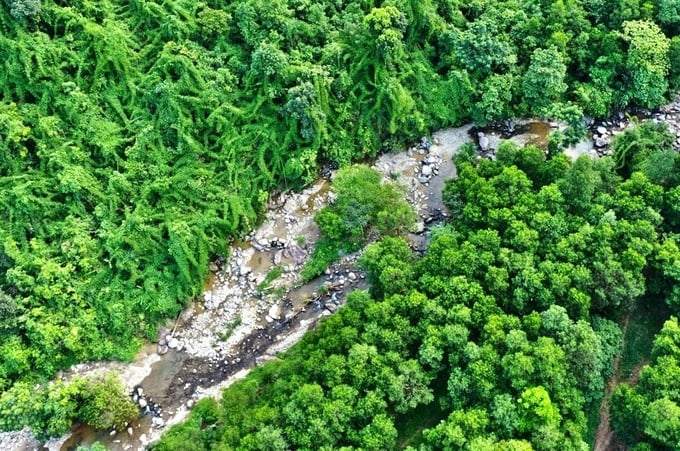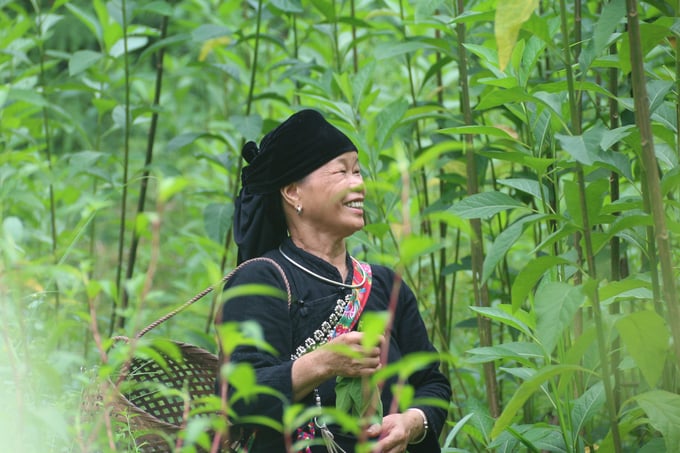June 19, 2025 | 00:41 GMT +7
June 19, 2025 | 00:41 GMT +7
Hotline: 0913.378.918
June 19, 2025 | 00:41 GMT +7
Hotline: 0913.378.918

Thai Nguyen province is focusing on developing a multi-functional forest ecosystem. Photo: PH.
Thai Nguyen province is currently shifting its focus towards developing a multi-functional forest ecosystem. Accordingly, the province aims to plant forests for timber and environmental protection, as well as profit from environmental and ecotourism services, and non-timber products. Thai Nguyen targets a timber product value of nearly 11 trillion VND by 2030. Notably, the value of non-timber forest products is projected to increase by 1.5 times, and revenue from ecotourism and resorts is projected to increase by 50% compared to 2020.
Thai Nguyen will prioritize the development of concentrated material forest areas and the expansion of large timber forest areas in order to achieve the aforementioned goals. As one of the key requirements for forest economy development, the province has promoted a gradual shift from small timber forest plantation models to large timber forest plantation models, focusing on districts with forest-related advantages such as Dinh Hoa, Dong Hy, Vo Nhai, Dai Tu, and Phu Luong.
Namely, the province must emphasize the quality of forest tree varieties and intensive farming techniques in order to increase productivity. Additionally, all plantation timber must be certified for sustainable forest management or assigned production unit codes to meet both domestic and international market demands.
With an abundant and standardized supply of raw materials, Thai Nguyen has been promoting the development of a corresponding modern and diverse forest product processing industry; and gradually reducing the output of raw product, small timber forest product and manual processing facilities. Notably, the province has attracted several investors to construct large-scale wood processing plants that specialize in products for export such as pellets, plywood, and veneer.
In addition to timber exploitation, forested regions within Thai Nguyen province are focusing on exploiting non-timber forest products, which include bamboo, rattan, palm, and medicinal plants under the forest canopy. Notably, several districts, such as Dinh Hoa and Vo Nhai, have established concentrated cinnamon production areas with the aim of reaching 11,500 hectares by 2030. Similarly, the province is developing several organic cinnamon production and processing models, featuring investments to construct processing plants with a capacity of approximately 30,000 tons per year.

Thai Nguyen province is developing towards exploiting non-timber forest products, which include bamboo, rattan, palm, and medicinal plants under the forest canopy. Photo: PH.
According to Dr. Tran Lam Dong, Deputy Director of the Vietnam Academy of Forest Sciences (Ministry of Agriculture and Rural Development), recent initiatives to develop production areas under forest canopies have prompted various forested regions to enhance the cultivation of medicinal plants for high economic returns.
"Namely, the cultivation of cardamom is concentrated in the provinces of Lai Chau, Lao Cai, Yen Bai, and Ha Giang; amomum in the provinces of Son La, Lai Chau, Lao Cai, Phu Tho, Thai Nguyen, and Ha Giang; morinda officinalis in the provinces of Quang Ninh, Bac Giang, Vinh Phuc, and Phu Tho; and ginseng in the provinces of Lai Chau, Lao Cai, Kon Tum, and Quang Nam. Consequently, specialized cultivation areas for various non-timber forest species have been established, providing raw materials for domestic consumption and export," shared Dr. Tran Lam Dong.
According to Deputy Director of the Department of Forestry Pham Hong Luong, the recently issued Project on Developing the Multifunctional Value of Vietnam's Forest Ecosystems by 2030, with a vision towards 2050, has assigned the forestry sector with maintaining a stable annual growth rate of 5% in terms of revenue from forest environmental services.
The project aims to develop forest environmental services by identifying and expanding various types of services, while effectively managing and utilizing resources from forest environmental services in compliance with legal regulations.

Thai Nguyen province is focusing on developing and implementing projects related to ecotourism, recreation, and relaxation in special-use and protection forests. Photo: PH.
Thai Nguyen province has identified the development of forest environmental services and the exploitation of ecotourism, recreation, and relaxation activities from forest ecosystems as priority goals for the immediate future. Additionally, the province aims to implement services for forest carbon sequestration and storage, reduce greenhouse gas emissions, and minimize deforestation and forest degradation.
Under instructions from the Ministry of Agriculture and Rural Development, Thai Nguyen is reviewing and developing a map of forest carbon stocks and a corresponding roadmap for carbon market development. Additionally, the province is actively promoting, guiding, and enhancing the effective use of revenue from forest environmental services to reinvest in sustainable forest protection, thereby promoting benefits for forest growers and owners.
Furthermore, the province is focusing on developing and implementing projects for ecotourism, recreation, and relaxation activities in special-use and protection forests within the province. Priority tasks include attracting investment for tourism development in the Than Sa - Phuong Hoang Nature Reserve in Vo Nhai district, the ATK Dinh Hoa Scenic Forest, and the Nui Coc Lake Protection Forest.
The province is also aiming to develop ecotourism in association with community-based tourism, historical tourism, adventure sports, and health care to improve revenue from forest ecosystems. Consequently, Thai Nguyen has emphasized the exapnsion of the domestic tourism market, with the goal of establishing interconnected tourism routes within and outside the province.
According to the Department of Forestry, various services within forest ecosystems, including the provision of timber and non-timber forest products, forest environmental services, carbon sequestration and storage, and ecotourism, have generated approximately 40 trillion VND annually.
"The forestry sector aims to diversify and expand revenue sources from various forest environmental services in compliance with legal regulations, with an emphasis on enhancing forest carbon sequestration and storage services; reducing greenhouse gas emissions by limiting deforestation and forest degradation; promoting sustainable forest management and green growth," emphasized Deputy Director Pham Hong Luong.
Translated by Nguyen Hai Long
![Turning wind and rain into action: [9] Digitizing hydrometeorological data in response to climate change](https://t.ex-cdn.com/nongnghiepmoitruong.vn/608w/files/news/2025/06/17/z6704423696987_15fd32ffc26d590d204d520c9dac6786-nongnghiep-165943.jpg)
(VAN) Farmers have begun accessing hydrometeorological applications to adjust their cropping schedules, aiming to ensure productivity and adapt to climate change.
![Turning wind and rain into action: [8] Real-time salinity detection and early warning technology](https://t.ex-cdn.com/nongnghiepmoitruong.vn/608w/files/news/2025/06/17/z6704423696987_15fd32ffc26d590d204d520c9dac6786-nongnghiep-151127.jpg)
(VAN) Thanks to the integration of modern hydrological-hydraulic models, remote sensing technologies, and artificial intelligence, the accuracy of hydrological forecasting has significantly improved.
![Turning wind and rain into action: [7] Early disaster warnings help marine farmers minimize losses](https://t.ex-cdn.com/nongnghiepmoitruong.vn/608w/files/news/2025/06/17/z6704423696987_15fd32ffc26d590d204d520c9dac6786-nongnghiep-142942.jpg)
(VAN) In recent years, thanks to early disaster warnings and forecasting, marine farmers in Khanh Hoa province have been able to reduce risks and losses, thereby improving production efficiency.
![Turning wind and rain into action: [6] ‘Four on-the-spot’ disaster management software](https://t.ex-cdn.com/nongnghiepmoitruong.vn/608w/files/news/2025/06/17/e5a48259d6a262fc3bb3-nongnghiep-183800.jpg)
(VAN) By simply activating the scenario on the disaster management software, the relevant authorities immediately know how many households need to be evacuated, where to evacuate them to, and by what means of transportation…
![Turning wind and rain into action: [5] Hue applies modern technology in disaster forecasting](https://t.ex-cdn.com/nongnghiepmoitruong.vn/608w/files/news/2025/06/17/z6704423696987_15fd32ffc26d590d204d520c9dac6786-nongnghiep-093938.jpg)
(VAN) In Hue city, modern technology has recently been applied in meteorological and hydrological forecasting and warning, helping to reduce the damage caused by natural disasters.

(VAN) A cutting-edge farming technique being implemented on an experimental ranch in Arizona's Sonoran Desert has already saved a billion gallons of water over five years, according to Civil Eats.

(VAN) Poultry and pig production and the environment can be boosted through enhanced water technology, according to new research.